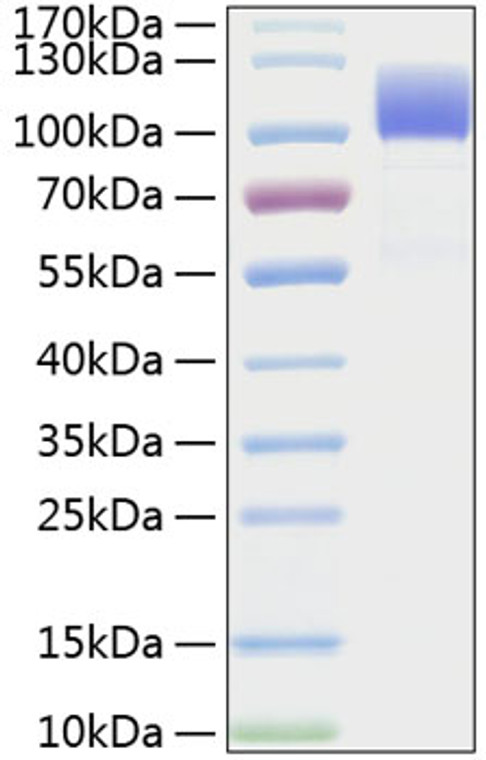| Host: |
HEK293 cells |
| Reactivity: |
Human |
| Note: |
STRICTLY FOR FURTHER SCIENTIFIC RESEARCH USE ONLY (RUO). MUST NOT TO BE USED IN DIAGNOSTIC OR THERAPEUTIC APPLICATIONS. |
| Short Description: |
Recombinant-Human CD6-C-hFc&His protein was developed from hek293 cells and has a target region of C-hFc&His. For use in research applications. |
| Formulation: |
Lyophilized from a 0.22 Mu m filtered solution of PBS, pH 7.4. Contact us for customized product form or formulation. |
| Immunoreactivity: |
Measured by its binding ability in a functional ELISA. Immobilized Human CD166 at 1 Mu g/mL (100 Mu L/well) can bind Human CD6 with a linear range of 4-389 ng/mL.2. Measured by the ability of the immobilized protein to support the adhesion of Jurkat |
| Gene Symbol: |
CD6 |
| Gene ID: |
923 |
| Uniprot ID: |
CD6_HUMAN |
| Immunogen Region: |
His18-Glu398 |
| Immunogen: |
Recombinant Human CD6 Protein is produced by HEK293cells expression system. The target protein is expressed with sequence (His18-Glu398) of human CD6 (Accession #NP_006716.3) fused with an Fc, 6×His tag at the C-terminus. |
| Tissue Specificity | Detected on thymocytes. Detected on peripheral blood T-cells. Detected on natural killer (NK) cells. Soluble CD6 is detected in blood serum (at protein level). Detected in spleen, thymus, appendix, lymph node and peripheral blood leukocytes. Expressed by thymocytes, mature T-cells, a subset of B-cells known as B-1 cells, and by some cells in the brain. |
| Post Translational Modifications | After T-cell activation, becomes hyperphosphorylated on Ser and Thr residues and phosphorylated on Tyr residues. Glycosylated. |
| Function | Cell adhesion molecule that mediates cell-cell contacts and regulates T-cell responses via its interaction with ALCAM/CD166. Contributes to signaling cascades triggered by activation of the TCR/CD3 complex. Functions as costimulatory molecule.promotes T-cell activation and proliferation. Contributes to the formation and maturation of the immunological synapse. Functions as calcium-dependent pattern receptor that binds and aggregates both Gram-positive and Gram-negative bacteria. Binds both lipopolysaccharide (LPS) from Gram-negative bacteria and lipoteichoic acid from Gram-positive bacteria. LPS binding leads to the activation of signaling cascades and down-stream MAP kinases. Mediates activation of the inflammatory response and the secretion of pro-inflammatory cytokines in response to LPS. |
| Protein Name | T-Cell Differentiation Antigen Cd6T12Tp120Cd Antigen Cd6 Cleaved Into - Soluble Cd6 |
| Cellular Localisation | Cell MembraneSingle-Pass Type I Membrane ProteinDetected At The Immunological SynapseIEAt The Contact Zone Between Antigen-Presenting Dendritic Cells And T-CellsColocalizes With The Tcr/Cd3 Complex At The Immunological SynapseSoluble Cd6: SecretedThe Origins Of The Secreted Form Are Not ClearBut It Might Be Created By Proteolytic Shedding Of The Ectodomain |
| Alternative Protein Names | T-Cell Differentiation Antigen Cd6 proteinT12 proteinTp120 proteinCd Antigen Cd6 Cleaved Into - Soluble Cd6 proteinCD6 protein |
Information sourced from Uniprot.org
12 months for antibodies. 6 months for ELISA Kits. Please see website T&Cs for further guidance









